OLDSMOBILE SILHOUETTE 1997 Owners Manual
Manufacturer: OLDSMOBILE, Model Year: 1997, Model line: SILHOUETTE, Model: OLDSMOBILE SILHOUETTE 1997Pages: 436, PDF Size: 21.87 MB
Page 111 of 436

Content Theft-Deterrent (Option)
If your vehicle has this option, it has a theft-deterrent
alarm system.
A light located on top of your instrument panel (near the
center
of the vehicle, next to the windshield) will flash
slowly to let everyone
know that the system has
been armed.
While armed, the doors will not unlock
with the power
lock switch. Once armed,
the alarm will
go off if someone tries to
enter the vehicle (without using the key chain
transmitter or a key), breaks a window, tries
to damage
the vehicle or turns the ignition on. The horn will sound
and your vehicle’s park lamps will flash for up to
two
minutes. The system will also cut off the fuel supply,
preventing the vehicle from being driven.
When the alarm is armed, the liftgate may be opened
with the key chain transmitter or with a key.
Arming with the Power Lock Switch
Your alarm system will arm when you use either power
lock switch to lock
the doors while any door or the
liftgate is open and the key is removed from the ignition
(if you would like to turn off power lock switch arming,
see “Locks and Lighting Choices”
in the Index).
The security light flashes quickly to let you know when
the system
is ready to arm with the power door lock
switches. The security light will stop flashing and stay
011, when you press the rear of the power lock switch, to
let you know the system is arming. After all doors and
the liftgate are closed and locked, the security light will
begin flashing
at a very slow rate to let you know the
system is armed.
2-23
ProCarManuals.com
Page 112 of 436

Arming with the Key Chain Transmitter
Your alarm system will arm when you use your key
chain transmitter to lock the doors
if the key is not in the
ignition. The security light will turn on to let you know
the system
is arming. After all doors and the liftgate are
closed and locked, the security light will begin flashing
at a
very slow rate to let you know the system is armed.
Arming with Your Key
Your alarm system will arm when you use your key to
lock the doors. The security light will turn on to let you
know the system is arming. After all doors and
the
liftgate are closed and locked, the security light will
begin flashing at
a very slow rate to let you know the
system is armed.
If you would like your key not to arm
the system, see “Locks and Lighting Choices”
in
the Index.
Arming Confirmation
If remote unlock confirmation is on (see “Locks and
Lighting Choices” in the Index), your park lamps will
flash briefly
to let you know when your alarm system
has armed.
Disarming with the Key Chain Transmitter
Your alarm system will disarm when you use your key
chain transmitter to unlock the doors. The security light
will stop flashing to let you know the system is no
longer armed.
Disarming with Your Key
Your alarm system will disarm when you use your key
to unlock the doors. The security light will stop flashing
to let you know the system is no longer armed. If
you
would like your key not to disarm the alarm system, see
“Locks and Lighting Choices”
in the Index.
Nuisance Alarms
If you experience nuisance alarms (alarms which are not
caused by the opening
of a door or the liftgate and are
not desirable), you may need to reduce the damage
detection sensitivity. Try programming the Content
Theft Deterrent to Mode
1. See “Locks and Lighting
Choices’’
in the Index.
If you continue to experience nuisance alarms, you
may want to
try turning off damage detection by
programming your Content Theft Deterrent to Mode
2.
See “Locks and Lighting Choices” in the Index.
2-24
ProCarManuals.com
Page 113 of 436

If you are still having trouble with nuisance alarms, you
can turn off the Content Theft Deterrent system by
programming your Content Theft Deterrent to Mode
3.
See “Locks and Lighting Choices” in the Index. See
your Retailer
or qualified technician for service.
Theft
Vehicle theft is big business, especially in some cities.
Although your Oldsmobile has a number of
theft-deterrent features, we know that nothing we
put on
it can make it impossible to steal. However, there are
ways you can help.
Key in the Ignition
If you leave your vehicle with the keys inside, it’s an
easy target for joy riders or professional thieves
-- so
don’t do it.
When you park your Oldsmobile and open the driver’s
door, you’ll hear a chime reminding you to remove
your
key from the ignition and take it with you.
Always
do this. Your steering wheel will be locked,
and
so will your ignition and transaxle. And remember
to lock the doors.
Parking at Night
Park in a lighted spot, close all windows and lock your
vehicle. Remember
to keep your valuables out of sight.
Put them
in a storage area, or take them with you.
Parking Lots
1.f you park in a lot where someone will be watching
your vehicle,
it’s best to lock it up and take your key.
But what
if you have to leave your key? What if you
have
to leave something valuable in your vehicle?
0 Put your valuables in a storage area, like your
glove box.
Lock all the doors except the driver’s.
2-25
ProCarManuals.com
Page 114 of 436

New Vehicle “Break-In”
NOTICE:
Your modern Oldsmobile doesn’t need an
elaborate “break-in.” But it will perform better
in the long run if you follow these guidelines:
Don’t drive at any one speed -- fast or
slow
-- for the first 500 miles (805 km).
Don’t make full-throttle starts.
200 miles (322 km) or so. During this time
your new brake linings aren’t yet broken
in. Hard stops with new linings can mean
premature wear and earlier replacement.
Follow this breaking-in guideline every
time you get new brake linings.
Don’t tow a trailer during break-in. See
“Towing a Trailer” in the Index for
more information.
Avoid making hard stops for the first
Ignition Positions
With the ignition key in the ignition switch, you ILA turn
the switch
to five positions.
E
ACCESSORY (A): An on position in which you can
operate your electrical power accessories. Press in the
ignition switch
as you turn the top of it toward you.
2-26
ProCarManuals.com
Page 115 of 436
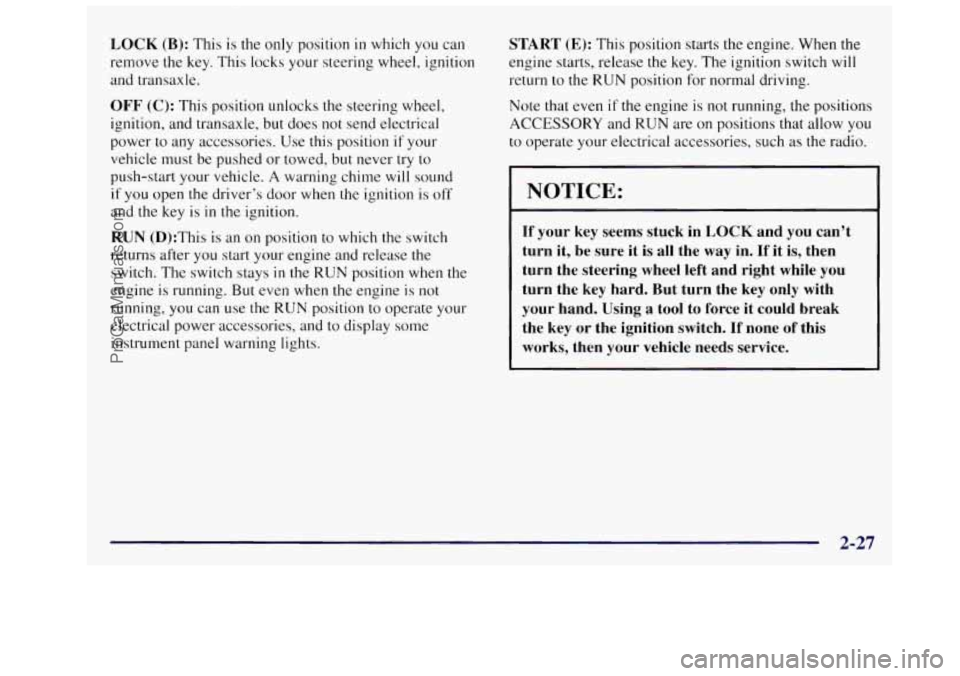
LOCK (B): This is the only position in which you can
remove
the key, This locks your steering wheel, ignition
and transaxle.
OFF (C): This position unlocks the steering wheel,
ignition, and transaxle, but does not send electrical
power to any accessories. Use this position if your
vehicle must be pushed or towed, but never try to
push-start your vehicle.
A warning chime will sound
if you open the driver’s door when the ignition is off
and the key is in the ignition.
RUN (D):This is an on position to which the switch
returns after
you start your engine and release the
switch. The switch stays
in the RUN position when the
engine is running. But even when
the engine is not
running, you can use the
RUN position to operate your
electrical power accessories, and to display some
instrument panel warning lights.
START (E): This position starts the engine. When the
engine starts, release the key. The ignition switch will
return to the
RUN position for normal driving.
Note that
even if the engine is not running, the positions
ACCESSORY and RUN are on positions that allow you
to operate your electrical accessories, such as the radio.
NOTICE:
If your key seems stuck in LOCK and you can’t
turn it, be sure it is all the
way in. If it is, then
turn the steering wheel left and right while
you
turn the key hard. But turn the key only with
your hand. Using
a tool to force it could break
the key
or the ignition switch. If none of this
works, then your vehicle needs service.
2-27
ProCarManuals.com
Page 116 of 436
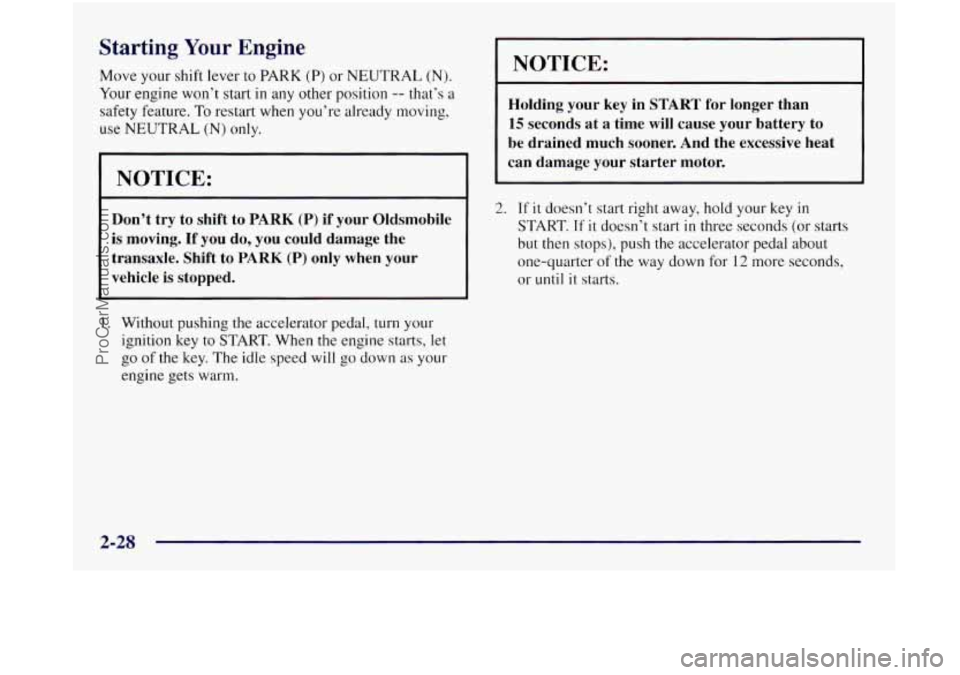
Starting Your Engine
Move your shift lever to PARK (P) or NEUTRAL (N).
Your engine won’t start in any other position -- that’s a
safety feature.
To restart when you’re already moving,
use NEUTRAL
(N) only.
NOTICE:
Don’t try to shift to PARK (P) if your Oldsmobile
is moving.
If you do, you could damage the
transaxle. Shift to
PARK (P) only when your
vehicle is stopped.
1. Without pushing the accelerator pedal, turn your
ignition key to START. When the engine starts, let
go of the key. The idle speed will go down as your
engine gets warm.
NOTICE:
Holding your key in START for longer than
15 seconds at a time will cause your battery to
be drained much sooner. And the excessive heat
can damage your starter motor.
2. If it doesn’t start right away, hold your key in
START. If it doesn’t start in three seconds (or starts
but then stops), push
the accelerator pedal about
one-quarter
of the way down for 12 more seconds,
or
until it starts.
2-28
ProCarManuals.com
Page 117 of 436
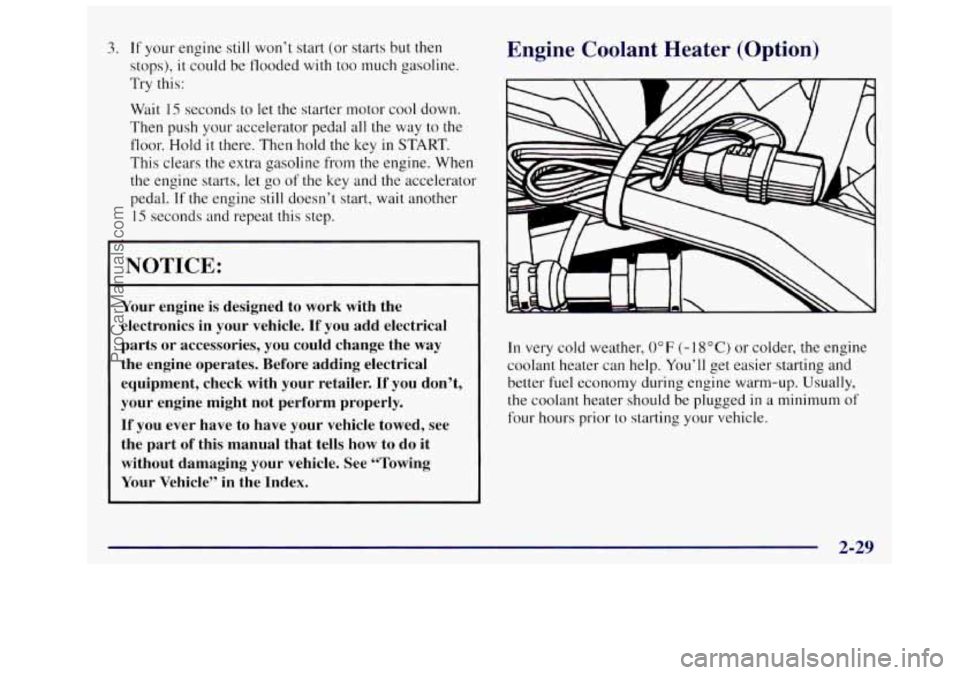
3. If your engine still won’t start (or starts but then
stops), it could be flooded with too much gasoline.
Try this:
Wait
15 seconds to let the starter motor cool down.
Then push your accelerator pedal
all the way to the
floor. Hold
it there. Then hold the key in START.
This clears the extra gasoline from
the engine. When
the engine starts,
let go of the key and the accelerator
pedal.
If the engine still doesn’t start, wait another
15 seconds and repeat this step.
NOTICE: I
Your engine is designed to work with the
electronics in your vehicle.
If you add electrical
parts or accessories, you could change the way
the engine operates. Before adding electrical
equipment, check with your retailer.
If you don’t,
your engine might not perform properly.
If you ever have to have your vehicle towed, see
the part of this manual that tells how to do it
without damaging
your vehicle. See “Towing
Your Vehicle” in the Index.
Engine Coolant Heater (Option)
In very cold weather, 0” F (- 18°C) or colder, the engine
coolant heater can help.
You’ll get easier starting and
better
fuel economy during engine warm-up. Usually,
the coolant heater should be plugged in a minimum of
four hours prior to starting your vehicle.
2-29
ProCarManuals.com
Page 118 of 436
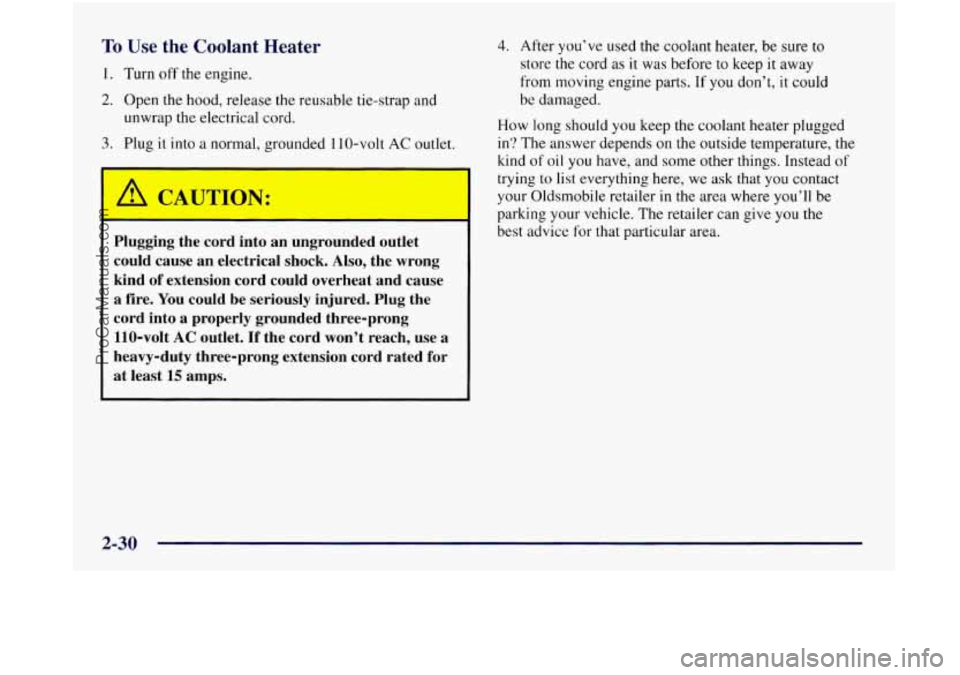
To Use the Coolant Heater
1. Turn off the engine.
2. Open the hood, release the reusable tie-strap and
3. Plug it into a normal, grounded 11 0-volt AC outlet.
unwrap the electrical cord.
ON:
I - - I
Plugging
the cord into an ungrounded outlet
could cause an electrical shock. Also, the wrong
kind
of extension cord could overheat and cause
a fire. You could be seriously injured. Plug the
cord into
a properly grounded three-prong
110-volt AC outlet. If the cord won’t reach, use a
heavy-duty three-prong extension cord rated for
at least
15 amps.
4. After you’ve used the coolant heater, be sure to
store the cord as it was before to keep it away
from moving engine parts. If you don’t, it could
be damaged.
How long should you keep the coolant heater plugged
in?
The answer depends on the outside temperature, the
kind of oil you have, and some other things. Instead of
trying to list everything here, we ask that you contact
your Oldsmobile retailer
in the area where you’ll be
parking your vehicle. The retailer can give you the
best advice
for that particular area.
2-30
ProCarManuals.com
Page 119 of 436
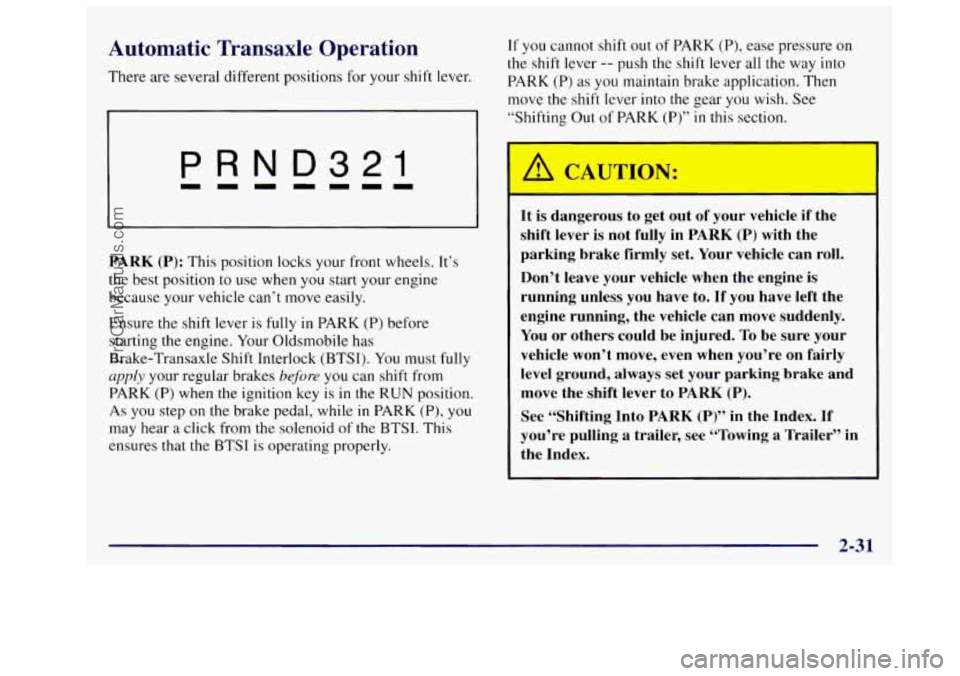
Automatic Transaxle Operation
There are several different positions for your shift lever.
PRND321
PARK (P): This position locks your front wheels. It’s
the best position to use when you start your engine
because your vehicle can’t move easily.
Ensure the shift lever is fully in PARK (P) before
starting the engine. Your Oldsmobile has
Brake-Transaxle Shift Interlock
(BTSI). You must fully
apply your regular brakes before you can shift from
PARK (P) when
the ignition key is in the RUN position.
As you step on the brake pedal, while in PARK (P), you
may hear a click from the solenoid of the BTSI. This
ensures that the BTSI
is operating properly.
If you cannot shi.ft out of PARK (P), ease pressure on
the shift lever
-- push the shift lever all the way into
PARK
(P) as you maintain brake application. Then
move the shift lever
into the gear you wish. See
“Shifting Out
of PARK (P)” in this section.
1 A CAUTION:
It is dangerous to get out of your vehicle if the
shift lever is not fully in
PARK (P) with the
parking brake firmly set. Your vehicle can roll.
Don’t leave your vehicle when the engine is
running unless you have to. If you have left the
engine running, the vehicle can move suddenly.
You or others could be injured.
To be sure your
vehicle won’t move, even when you’re on fairly
level ground, always set your parking
brake and
move the shift lever to
PARK (P).
See “Shifting Into PARK (P)” in the Index. If
you’re pulling a trailer, see “Towing a Trailer” in
the Index.
I
2-31
ProCarManuals.com
Page 120 of 436
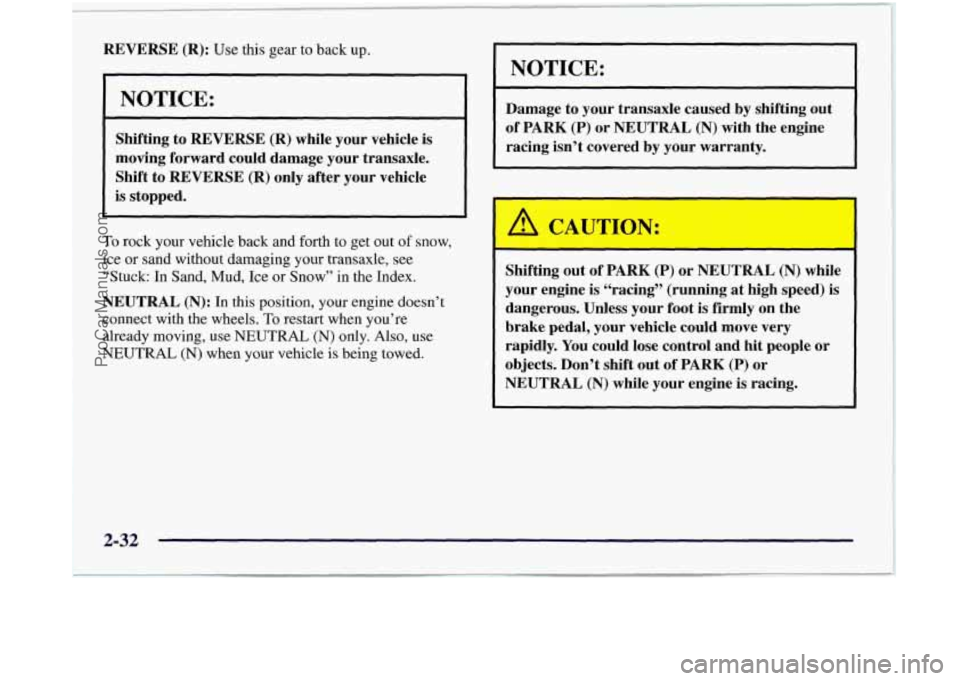
REVERSE (R): Use this gear to back up.
NOTICE:
Shifting to REVERSE (R) while your vehicle is
moving forward could damage your transaxle.
Shift to REVERSE
(R) only after your vehicle
is stopped.
To rock your vehicle back and forth to get out of snow,
ice or sand without damaging your transaxle,
see
“Stuck: In Sand, Mud, Ice or Snow” in the Index.
NEUTRAL (N): In this position, your engine doesn’t
connect with the wheels. To restart when you’re
already moving, use NEUTRAL
(N) only. Also, use
NEUTRAL (N) when your vehicle is being towed.
NOTICE:
Damage to your transaxle caused by shifting out
of PARK (P) or NEUTRAL (N) with the engine
racing isn’t covered by your warranty.
Shifting out of PARK
(P) or NEUTRAL (N) while
your engine is “racing” (running at high speed) is
dangerous. Unless your foot is firmly
on the
brake pedal, your vehicle could move very
rapidly. You could lose control and
hit people or
objects. Don’t shift out
of PARK (P) or
NEUTRAL (N) while your engine is racing.
2-32
ProCarManuals.com